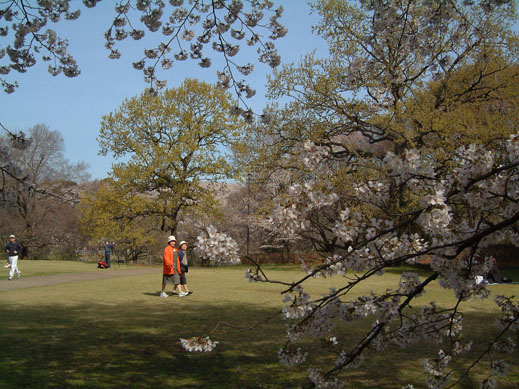 |
Focus features two in-depth reviews each month of fine art, architecture and design exhibitions and events at art museums, galleries and alternative spaces around Japan. The contributors are non-Japanese art critics living in Japan. |
|
|
 |
 |
 |
Radiant Moments at the Tokyo Metropolitan Museum of Photography
Roger McDonald |
 |
 |
| Yuji Obata, from "Wintertale" (2003) |
The New Snapshot. Contemporary Japanese Photography, vol.9: Radiant Moments was the title of a recent exhibition at the Tokyo Metropolitan Museum of Photography in Ebisu. Notwithstanding the highly ambitious curatorial imperative to investigate "the new snapshot" through the work of the six photographers in the show, I found myself taken in by the works presented. The first thing that struck me was the sympathetic installation layout, which gave each artist a room to show their images. This resulted in a series of micro-exhibitions by each artist, offering short stories or vignettes around some common theme or place. Most of the photographers showed series or multiple series of works, sometimes hung densely on the walls. Haruko Nakamura's vivid images of people and animals in a harmonious Tuscan landscape exemplified this photo book format. A more archival, anthropological approach could be seen in the images of Shigeo Yuki, who has amassed over 70,000 digital photographs of Tokyo and serialized them under headings such as "Tokyo Nostalgia" and "Urban Gathering." Yuki's photography reminded me of social street photography in the tradition of Eugene Atget or Garry Winogrand, documenting the disappearing city or the overlooked.
Two artists particularly stood out for me. Yuji Obata's "Wintertale" (2003-07) was a series of images taken in sub-zero Hokkaido, documenting the harsh winter days and nights there: pictures of speed skaters on a track at night, lit by floodlights; empty snowy night streets; close-ups of ice crystal formations; running horses; a snow-covered river; the skating circuit at dusk. Like their title suggests, Obata's photographs convey stories about a place far away from the noise of Tokyo. Drawing on aspects of 19th-century Romanticism, travel photography and the blurry effects of Alexy Brodovitch, to whom Obata refers in the catalogue, "Wintertale" shows something of the normally overlooked Far North of Japan and the different air there.
 |
Chikako Yamashiro, from "Choros of the Melodies" (2010)
|
Chikako Yamashiro is from Okinawa in the southernmost part of Japan. Though she normally works in video and performance, referencing complex socio-historical issues of Okinawa's relationship with mainland Japan and the United States, her new photographic series "Choros of the Melodies" (2010) is a stunning installation of different-sized color images in a darkened space. Yamashiro photographed women lying in the forests of Okinawa, the piercing tropical sunlight fractured by the trees into dappled effects that form strong contrasting patterns across each image. The forests of Okinawa remain places connected to the past -- as battlegrounds, as graveyards, and as sacred sites where ancient women-only rituals such as the Utaki are held. Old and young women lie on the grass under the shadows -- hiding? listening? singing? In contrast to the more documentary style of Obata, Yamashiro's series clearly employed a degree of staging.
What both have in common seems to be an acute sensitivity that photographs can powerfully tell stories from faraway places. Central to this is probably the photographic image's ability to convey the texture or mood of a place through light and shadow, blurry effects, and the series format. This has clearly been a key aspect of much photojournalism throughout the 20th century: locating photography within a complex orbit of propaganda and manipulation as well as generating new kinds of knowledge and awareness about things overlooked. It was this geographically distant atmosphere conveyed by Obata and Yamashiro that seemed most pertinent in Tokyo where, as the artist Robert Smithson once said, entropy (the repetitive cycle of consumerism) has a tendency to make everything, including places, the same.
 |
Shigeo Yuki, from "Tokyo Is" (2002)
Images courtesy of Tokyo Metropolitan Museum of Photography
|
|
 |
 |
Roger McDonald
Roger McDonald was born and brought up in Tokyo, educated in the UK, and returned to live in Japan in 2000 after completing his PhD. He has worked on the Yokohama Triennale 2001 as assistant curator, the Singapore Biennale 2006 as curator, and organised a number of exhibitions and projects independently. He is deputy director of the non-profit curatorial collective Arts Initiative Tokyo, and teaches at Musashino and Joshibi Art Universities. |
|
 |
|